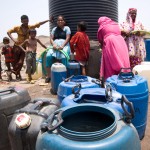You are here
Promoting Safe Water for All
Lack of access to safe water affects more than 1 billion people in the developing world. Annually, 2 to 3 million children under age 5 die of diarrheal diseases, often acquired through exposure to contaminated water. Through CDC-supported programs, families in developing countries are learning that simply by treating their drinking water with diluted chlorine bleach; storing it safely in a narrow-mouthed, lidded vessel; and washing their hands with soap and water, they can ensure a supply of safe, clean water in their homes. The simple, yet effective, technology was developed by CDC and the World Health Organization and is called the Safe Water System. The CDC Foundation connects CDC with a wide range of outside partners to launch or expand safe water programs all over the world.


Rob Quick, M.D., M.P.H., medical epidemiologist with CDC's enteric diseases branch, works to launch and implement many of CDC’s safe water projects. “The Safe Water System itself is a simple technology,” said Quick. “But, setting up effective safe water programs in developing countries can be very complex. We rely heavily on our partners here at home and in the field.”
Quick explains that CDC works with local partners to determine appropriate packaging for the system, translate educational materials, and develop plans to distribute and encourage use of the product. Resources must be available to produce the locally branded diluted bleach solution and safe water storage containers, and, once the project is underway, CDC also must have the capacity to work with local partners to conduct research on usage rates of the system and its effectiveness in preventing disease and death.
Through partnerships with the Bill & Melinda Gates Foundation, the Procter & Gamble Company, Vestergaard Frandsen SA, the American Chemistry Council, Medentech and Arch Chemicals, the CDC Foundation has helped CDC support safe water projects in communities in Afghanistan, Bangladesh, China, Ghana, Kenya, Mozambique, Pakistan and the Philippines. After the 2004 tsunami hit Southeast Asia, a gift to the CDC Foundation from an individual donor helped support a CDC safe water project in Sri Lanka.
“We really have appreciated the role the Foundation has played in our projects over the years because it does provide a way for the private sector and other donors to support our projects,” said Quick. “Given that well over 1 billion people lack access to safe water, there are countless ways for us to put that support to good use.”
Gangarosa Endowment for Safe Water
Reflecting a lifelong commitment to provide safe water around the world, Eugene Gangarosa, M.D., and his wife, Rose, established the Gangarosa Endowment for Safe Water in May 2000 to provide an ongoing source of support for CDC's safe water initiatives. In his words, “CDC’s Safe Water Program provides us such a unique opportunity to help by addressing in a meaningful way one of the most pressing public health needs of our time - safe water for all. Rose and I know of no better investment in our children’s future than this to save lives, improve quality of life and contribute to global stability.”
“We are able to tap the Gangarosa Endowment at critical times to get safe water projects off the ground,” CDC’s Rob Quick said, “It doesn’t have to be a large amount of money. Sometimes you just need a catalyst, a way to pay certain costs to get over the hump to make something happen. The Foundation has often provided a conduit for doing that.”
MAKE A GIFT Make a gift to the Gangarosa Endowment for Safe Water. For a limited time, every gift that is made to the endowment up to a total of $3,000 will be matched dollar for dollar by the Gangarosas. Give Now